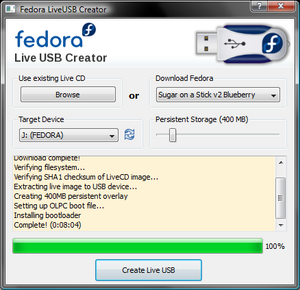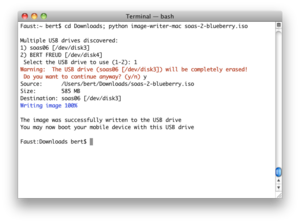Difference between revisions of "SoaS Blueberry Instructions"
Interested (talk | contribs) |
Interested (talk | contribs) |
||
| Line 78: | Line 78: | ||
'''To download Sugar on a Stick''' | '''To download Sugar on a Stick''' | ||
*Download the liveUSB image http://download.sugarlabs.org/soas/releases/soas-2-blueberry.iso | *Download the liveUSB image http://download.sugarlabs.org/soas/releases/soas-2-blueberry.iso | ||
| − | * Verify the file was downloaded properly | + | * Verify the file was downloaded properly ''by calculating its SHA-1 checksum:''<br>Open the Terminal Utility and type the following code into the Terminal Window. Press the return key to run the command. |
| − | **Mac OS version ≥10.6 <code> | + | <!-- "md5" will work too, but creates a different checksum e.g. ''$ md5 /Downloads/soas-2-blueberry.iso'' --> |
| − | ** Mac OS version ≤10.5 <code> | + | **Mac OS version ≥10.6$ <code> shasum ~/Downloads/soas-2-blueberry.iso</code> |
| + | ** Mac OS version ≤10.5$ <code> openssl sha1 ~/Downloads/soas-2-blueberry.iso</code> | ||
** Compare the result to the string shown here.<br> 8022b68433295f12fbfffa66bf49205851a6a1e0 | ** Compare the result to the string shown here.<br> 8022b68433295f12fbfffa66bf49205851a6a1e0 | ||
Revision as of 21:31, 28 March 2010
For Windows Users
Persons using PCs running Windows have two options for creating a Sugar/Blueberry USB flash drive:
- Option #1: Use LiveUSB Creator from within Windows to create a Sugar-on-a-Stick Live USB with a compressed filesystem.
|
- Option #2: (ADVANCED USERS ONLY) Create a bootable Sugar/Blueberry USB flash drive that does not have a compressed filesystem. This option requires at least a 4GB drive.
- WARNING: MAKING A MISTAKE IN THIS PROCEDURE COULD WIPE YOUR PC'S HARD DISK!!!!
- In Windows, download the latest version of the Live CD image, and burn the image to a CD.
- Follow the instructions here to create the bootable Sugar/Blueberry USB flash drive by (i) booting the PC into Sugar with the CD and (ii) running ZyX-LiveInstaller within the Terminal activity. You will also need a spare, blank (or erasable) USB flash drive -- preferably manufactured by a different manufacturer than the target USB -- to use as a swap drive during the procedure. Any data on the swap drive will be wiped.
Notes:
- If you do Option #1 often, you may want to download the Blueberry CD Image once. Then, when it comes to create the flash drive, hit the Browse button and select the downloaded file rather than selecting "Blueberry" from the menu as above.
- Option #1 creates an SoaS that cannot detect when its drive space eventually runs out, causing stick failure.
- Option #2 creates a more-robust, more-stable drive whose free space can be monitored using the Terminal activity. Non-compressed SoaS drives, however, are not bootable with a boot helper CD.
For GNU/Linux Users
1-)Linux Users will use a slightly different approach than Windows Users to ensure maximum compatibility with different distributions. Please follow the instructions carefully to ensure your data is preserved.
If you are a Fedora User, run the following command:
yum install liveusb-creator
Then download soas-2-blueberry.iso and select it by using the Browse button. You can check to make sure that the .iso downloaded properly by comparing the sha1sum to the one here:[1](sha1sum)
sha1sum soas-2-blueberry.iso 8022b68433295f12fbfffa66bf49205851a6a1e0
- Launch LiveUSB Creator and follow the instructions above.
2-)If you use any other distribution, download the image-writer tool from here and the live image from here.
This solution will not create a persistent storage overlay
- Open a terminal and become root, either by using su or sudo.
- Enter the following command: ./image-writer soas-2-blueberry.iso
- WARNING: If you proceed here, your flash drive will be wiped!
- The script will output a device name; confirm that it matches with your flash drive.
- You will be notified once the process has finished.
3-)zyx-liveinstaller:[2]
4-)Unsupported instructions for creating a key with persistent storage for Blueberry: [3] and on other distributions are available here:[4]
For Mac OS X Users
Apple Macintosh computers with an Intel Processor are capable of running Sugar on a Stick v2 Blueberry.
Fedora Core has been ported to run on the powerPC processor, Sugar has not. At this time, you must have an Intel processor to run Sugar.
It is possible to download Sugar and flash usb drives with a powerPC Mac. It is also possible to develop activities with a powerPC Mac.
The use of powerPC Mac as a School Sever has not been tested.
To identify the Mac's processor
Choose Apple menu > About This Mac. The processor type appears at the top of the list.
To download Sugar on a Stick
- Download the liveUSB image http://download.sugarlabs.org/soas/releases/soas-2-blueberry.iso
- Verify the file was downloaded properly by calculating its SHA-1 checksum:
Open the Terminal Utility and type the following code into the Terminal Window. Press the return key to run the command.- Mac OS version ≥10.6$
shasum ~/Downloads/soas-2-blueberry.iso - Mac OS version ≤10.5$
openssl sha1 ~/Downloads/soas-2-blueberry.iso - Compare the result to the string shown here.
8022b68433295f12fbfffa66bf49205851a6a1e0
- Mac OS version ≥10.6$
To install Sugar onto a Stick
- Download our image-writer for Mac http://download.sugarlabs.org/soas/releases/image-writer-mac
- Eject all USB drives. Insert the flash drive you wish to install Sugar on a Stick.
WARNING: your flash drive will be wiped in the next step! All partitions will be erased. - Open the Terminal Utility and type the following command
cd Downloads; python image-writer-mac soas-2-blueberry.iso
Press the return key to run the command.
To boot Sugar on a Stick
Proceed as stated in the instructions for Linux Users.
Boot Helper
If your machine doesn't support booting from USB devices, then download the soas-2-boot.iso and burn it to a CD. ImgBurn is a free Windows application to do so, in case your current computer does not come with such a software.
- Use the Windows Explorer to name your USB flash drive FEDORA (from the Properties dialog for your device), as otherwise, it won't be recognized by the boot-helper CD.
- Put both the boot-helper CD and the USB flash drive in your computer and let it boot from the CD.
If your boot hangs, you may need to modify the boot command by appending:
selinux=0
You do this by interrupting the Helper CD boot by hitting the Esc key once the initial splash-screen appears. You should see a list of four boot options. At this point, hit the Tab key. The command line should appear. Add selinix=0 to the end of the line and hit Return (or Enter). The boot should proceed from here as normal.

